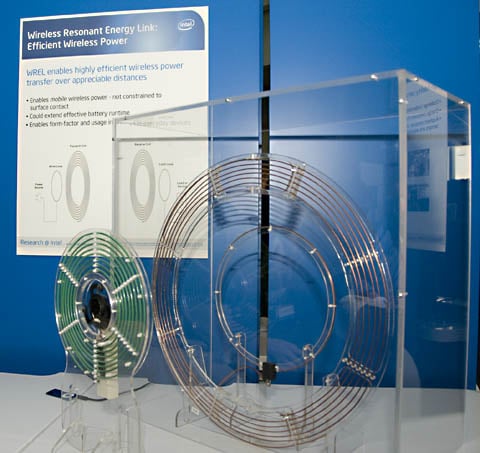The demo setup included a hefty transmitter and receive-coil pair in which the receive coil had at its center a small speaker, with both the audio signal and the power required to drive the speaker being transmitted wirelessly.
The WREL, as its name implies, transmits power by setting up a resonant relationship between the transmitter and the receive coil, much as does the battery recharger in your wireless electric toothbrush.
However, as Intel researcher Emily Cooper told The Reg, the WREL's power transmission is "very different from the electric toothbrush charger [power] that falls off after about a millimeter."
Although the demo was transmitting only about one or two watts at a distance of over a meter, Cooper claimed that in Intel's Seattle lab, they've managed to power a netbook at distances of between one and two meters, providing between 14 and 20 watts. She also said that lab tests had powered 40 and 60-watt light bulbs.

Intel's wireless-power prototype - transmitter on the right, speaker-equipped receive coil on the left
Cooper demonstrated that the receiver didn't drop or attenuate the signal when it changed its orientation in the transmitted beam. Even at a 90 degrees orientation to the transmitter, the receive coil's tinny speaker's tunes remained equally tinny. Her explanation: "As long as we're capturing some of the flux from this source, we can transduce that."
She also pointed out that the transmitted power is not subject to the familiar inverse square law, which decrees that signal strength is inversely proportional to the square of the distance from the transmitter. "That's what's interesting about this coupling mechanism," she said, "there are ways to make the transfer efficiency constant until you reach a certain point."
No comments:
Post a Comment